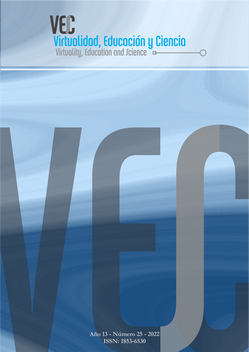Teacher training experience in creating digital resources in H5P: toolbox for interactivity
DOI:
https://doi.org/10.60020/1853-6530.v13.n25.37704Keywords:
interactivity, H5P, MoodleAbstract
This paper addresses the conceptual framework of the interactivity of materials in distance education and describes a teacher training experience for teachers of secondary level courses. The training presents teachers with a diverse range of tools that can be incorporated into the virtual classroom to promote interactivity in technological mediation, between the student and the different elements of the educational proposal. The participants were proposed the pedagogical approach to interactivity through free use tools nucleated under the name H5P, recently incorporated as a native complement in the latest versions of the Moodle environment, in order to enrich the educational proposals in a virtualization framework massive as a consequence of the Covid-19 pandemic. The didactic strategy and the results obtained are detailed.
References
BEAUCHAMP, G. y KENNEWELL, S. (2010). Interactivity in the classroom and its impact on learning, Computers & Education, 54, pp.759–766.
BERRÍOS MUÑOZ, A. (2013). El componente interactivo en materiales digitales para la enseñanza de la gramática castellana en L1 [tesis de Magister]. En línea:
http://diposit.ub.edu/dspace/bitstream/2445/48268/1/TFM_AndreaBerr%C3%ADosM_Final.pdf [10/05/21].
BUHU, A. y BUHU, L. (2017). Developing interactive elearning courses based on HTML5 for students in textile engineering, 9° Conferencia internacional sobre Educación y Nuevas Tecnologías de Aprendizaje, Barcelona, España.
CÁRDENAS-CLAROS, M. y GRUBA, P. (2009). Help Options in CALL: A Systematic Review. CALICO Journal, 27(1), pp. 69-90.
CHISAG, J.C.; FLORES LAGLA, G.A.; VENEGAS ALVAREZ, G.S.; CADENA MOREANO, J.A.; GUAYPATÍN PICO, O.A.; IZURIETA CHICAIZA, E.M. (2017). Utilización de recursos didácticos interactivos a través de las TIC´S en el proceso de enseñanza aprendizaje en el área de matemática. Boletín Redipe, 6(4), pp. 112-134.
GARCÍA ARETIO, L. (2011). La interacción es elemento definitorio del hacer educativo, Entrevista en Revista Learning Review España, 15. En línea: http://aretio.blogspot.com/2011/07/nueva-entrevista-la-interaccion-es.html [02/04/21]
GUEVARA, R.; BOTERO, R. y CASTRO, C. (2015). Una revisión a los niveles de interactividad de los contenidos digitales. Nuevas ideas en informática educativa, pp. 469-473.
HEIFT, T. (2004). Corrective feedback and learner uptake, CALL. ReCALL, 16(2), pp. 416-431.
HILLMAN, D.; WILLIS, D.J. y GUNAWARDENA, C. (1994). Learner-Interface Interaction in Distance Education: An extension of contemporary models and strategies for practitioners. The American Journal of Distance Education, 8(2), pp. 30-42.
MENA, M.; RODRÍGUEZ, L. y DIEZ, M.L. (2005). Diseño de Proyectos de Educación a Distancia. Páginas en Construcción. Buenos Aires. Editorial La Crujía.
MOORE, M. (1989). Three Types of Interaction. American Journal of Distance Education. 3, pp. 1-7. En línea:
https://www.researchgate.net/publication/237404371_Three_Types_of_Interaction
URIBE GONZÁLEZ, R; DUQUE MÉNDEZ, N. y MORENO CADAVID, J. (2018). Propuesta para la medición de la interactividad en ambientes de enseñanza-aprendizaje. Revista Espacios, 39(53), pp. 12-24.
VALLEJO A.E. y GONZALEZ A.H. (2018). Diseño de videos más efectivos, enriquecidos con interactividad, utilizando la herramienta H5P [ponencia]. V Foro Internacional de Educación en Entornos Virtuales y XVIII Encuentro AIESAD. Universidad Nacional de Quilmes, Quilmes. En línea: http://sedici.unlp.edu.ar/handle/10915/81177 [10/03/21].
YACCI, M. (2000). Interactivity Demystified: A Structural Definition for Distance Education and Intelligent Computer-based Instruction. Educational Technology, 40(4), pp. 5-16. En línea: http://www.ist.rit.edu/~may/interactiv8.pdf [10/03/21].
ZANGARA, M.A. (2018). Interacción e interactividad en el trabajo colaborativo mediado por tecnología informática [tesis doctoral]. En línea:
http://sedici.unlp.edu.ar/bitstream/handle/10915/67175/Tesis.pdf-PDFA.pdf?sequence=1 [01/02/21].
Downloads
Published
Issue
Section
License

This work is licensed under a Creative Commons Attribution-NonCommercial 4.0 International License.
The generation of derivative works is allowed as long as it is not done for commercial purposes. The original work may not be used for commercial purposes.


